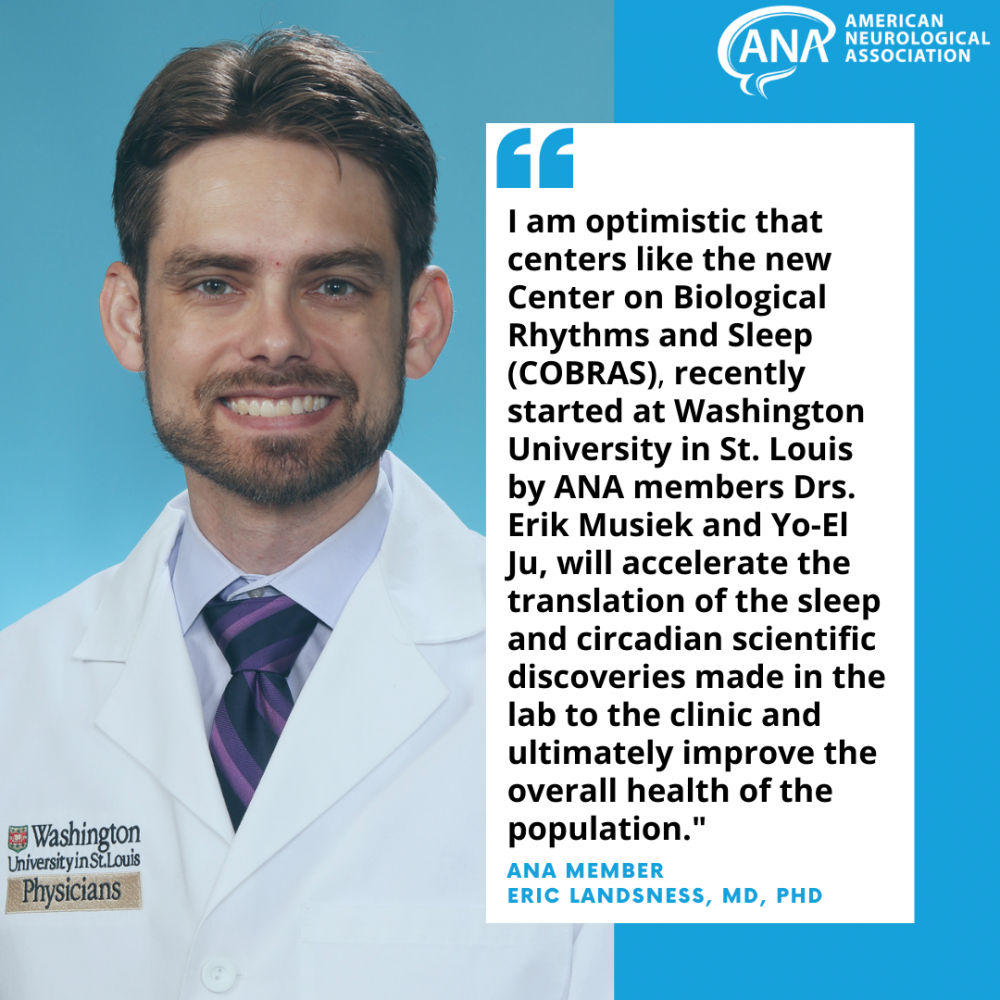In this month’s ANA Q&A, the American Neurological Association (ANA) spoke with Eric Landsness, MD, PhD, assistant professor of Neurology at the Washington University Physicians. Dr. Landsness discusses the connection between sleep and stroke, the research he and his lab are partaking in, and more.
What should the public understand about sleeping disorders that may not be known?
Sleep disorders are very common with about 22 million people suffering from sleep apnea each year. It is well established that sleep apnea is associated with non-restorative sleep, excessive daytime sleepiness and difficulty with concentration and memory. However, what people are less aware of, and the public needs to recognize, is that untreated sleep apnea, increases the risk of stroke by 2-3 times.
Stroke is also a huge problem in the United States, with millions of Americans having strokes every year, leading to long-term disability. There are lots of risk factors, including high blood pressure, diabetes, high cholesterol, and smoking, but upwards of 70% of post-stroke patients have some form of sleep apnea. So, there is big push to better understand how much sleep apnea contributes to stroke risk and if treating sleep apnea can prevent strokes from occurring in the first place.
What’s even more interesting is whether treating sleep apnea after a stroke helps people recover better from strokes or prevents them having additional strokes. Previous studies have hinted that treating sleep apnea, helps, but they have been limited by small sample sizes. To definitively answer this question, I am collaborating with Drs. Devin Brown and Ron Chervin at the University of Michigan, whom I met at an ANA Annual Meeting. As part of a clinical trial called Sleep SMART sponsored by the NINDS Stroke Net Division we are screening stroke patients for sleep apnea and comparing the standard treatment for sleep apnea, continuous positive airway pressure (CPAP), with standard usual care after stroke. At three and six months after random assignment to one approach or the other, we are comparing stroke-related outcomes with those of the control group. The aim is to determine whether going forward, future patients who have a stroke should be screened and treated for OSA.
How are you approaching sleep disorders in patients who have suffered strokes?
My research aims to study the connection between plasticity-dependent mechanisms for stroke recovery and sleep-dependent plasticity. My overall objective is to understand how sleep modulates stroke recovery and to discover new sleep-focused treatments and interventions to improve outcomes in patients with neurological disease. In order to do this I'm using an animal model and wide-field high-resolution optical fluorescence imaging to examine how sleep is disrupted in the brain after a stroke. Particularly, I’m interested in how slow wave sleep (SWS), the large, slow oscillations in your brain that have been linked to brain plasticity, correlate with recovery. Of interest, my lab has identified regionally specific changes in SWS that are able to predict recovery. We are currently investigating how manipulating SWS in these specific regions of cortex can affect stroke recovery. Ultimately, this knowledge may identify novel sleep-focused therapies that could enhance recovery after stroke, which would greatly improve health for patients, reduce disability, and enrich quality of life.
What other work are you undertaking to increase understanding or better treatment for sleeping disorders forward?
I’m very excited about the new Center on Biological Rhythms and Sleep (COBRAS) recently started at Washington University in St. Louis by ANA members Drs. Erik Musiek and Yo-El Ju. We are a multidisciplinary center across the entire campus designed to bring together researchers and clinicians to investigate the impact of sleep and circadian rhythms on disease. COBRAS offers core facilities and services for human and mouse sleep/circadian research, and hosts a number of working groups of scientists and clinicians focused on sleep/circadian research in diverse clinical areas. Having a comprehensive center such as COBRAS has facilitated my collaboration with anesthesiologist, Dr. Aaron Norris where we are investigating how changes in temperature may be neuroprotective after brain injury. I am also excited because COBRAS is designed to engage and educate the community about sleep and circadian focused health initiatives. For instance, we are working with local school districts to educate them about the health benefits of starting school at later times and have been engaging with the state legislature about the health consequences of Standard vs Daylight Savings Time. Ultimately, I am optimistic that centers like COBRAS will accelerate the translation of the sleep and circadian scientific discoveries made in the lab to the clinic and ultimately improve the overall health of the population.
How has the ANA supported your career and/or work in this area?
The ANA has been instrumental for my career as a junior and early career member. The Annual Meeting has provided me with a platform for discussing my science and learning about the latest neuroscience. I currently chair the Emerging Scholars section, which is designed to showcase the most exciting science from our early-career members. Make sure to check it out at #ANA2021
Finally, the ANA has encouraged my growth as a leader. Through close collaboration with the ANA Board, and Dr. Elizabeth Silbermann at OHSU, we have started the Junior and Early Career Membership Committee which is designed to meet the unique needs of early trainees and strengthen the pipeline of academic neurologists going forward.
Follow Eric Landsness on Twitter at @EricLandsness
Want to learn about more of the groundbreaking research being conducted by ANA members? Read past editions of The ANA Q&A.

